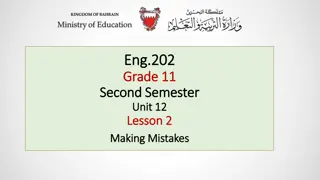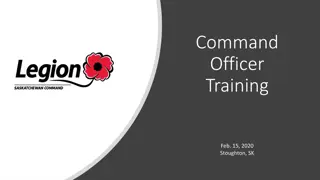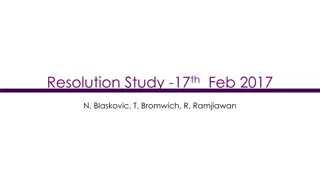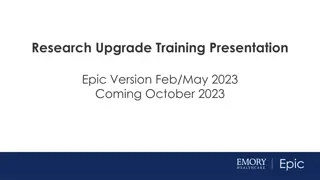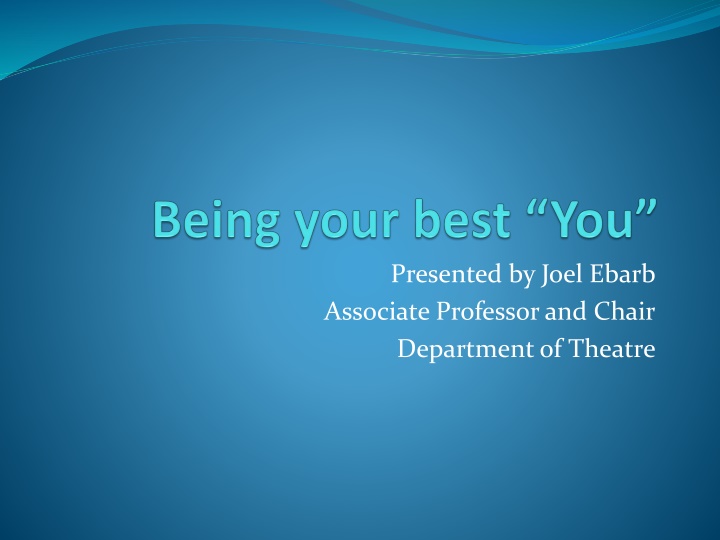
Personal Branding and Identity Reflection in Theatre Department by Joel Ebarb
Delve into the world of personal branding and identity reflection through the lens of Joel Ebarb, an award-winning Associate Professor and Chair in the Theatre Department at Purdue University. Explore the concept of persona, voice, body language, confidence, and networking in shaping professional personality. Discover how to analyze, understand, and enhance your public persona to align with your true self in both personal and professional settings.
Download Presentation

Please find below an Image/Link to download the presentation.
The content on the website is provided AS IS for your information and personal use only. It may not be sold, licensed, or shared on other websites without obtaining consent from the author. If you encounter any issues during the download, it is possible that the publisher has removed the file from their server.
You are allowed to download the files provided on this website for personal or commercial use, subject to the condition that they are used lawfully. All files are the property of their respective owners.
The content on the website is provided AS IS for your information and personal use only. It may not be sold, licensed, or shared on other websites without obtaining consent from the author.
E N D
Presentation Transcript
Presented by Joel Ebarb Associate Professor and Chair Department of Theatre
Who am I? Joel Ebarb Purdue University Department of Theatre Associate Professor and Chair Award-winning educator Popular lecturer and speaker Native of Shreveport, Louisiana (b. 1967) BA Northwestern State University of Louisiana (Natchitoches) MFA University of Houston 16 years at Purdue, over 25 years in the performing arts
What is my life? Purdue University Department of Theatre Patti and Rusty Rueff School of Visual and Performing Arts Theatre - 4 productions per year Art Galleries - new show every week Dance Concerts - 4 shows per year
Learning Outcomes PERSONA: Analyze your personal and professional personality VOICE: Understand the qualities and potential of your own voice BODY: Identify and assess your personal style (clothing and body language) CONFIDENCE: Develop skills to improve personal and professional confidence NETWORKING: Who are you and what is your life?
Learning Outcomes PERSONA: Analyze your personal and professional personality VOICE: Understand the qualities and potential of your own voice BODY: Identify and assess your personal style (clothing and body language) CONFIDENCE: Develop skills to improve personal and professional confidence NETWORKING: Who are you and what is your life?
What is Persona Persona is a word we can use to describe our perceived identity, our perceived personality Another word for personal brand or reputation Perception is reality Your persona may be a reflection of the real you or it may be a carefully cultivated version of you that is appropriate for your professional life TRUE FACT: We are in complete control of our persona, we control our brand, and we can control our own spin
Brainstorm Spend a few minutes listing words or phrases that best describe your public persona (how we think we are perceived by others) Examples: dependable, trustworthy, shy, always late, too emotional, a good friend, lazy, someone who gossips, a tough broad , everyone s hero, classy, boring, aggressive, etc. Be as honest as you can with yourself re: how you feel you are perceived by others (List the descriptors in a column to the left of your paper)
Evaluate Look at the words or phrases you selected to describe your public persona Beside each word or phrase, write TRUE or FALSE If you write FALSE, write the TRUTH in a third column
Evaluate Look at the words or phrases you selected to describe your public persona Beside each word or phrase, write TRUE or FALSE If you write FALSE, write the truth in a third column Now, in a single sentence, define your preferred persona Example: Joel Ebarb is a charismatic and conscientious leader; he is decisive, collaborative, and optimistic.
Goals and Strategies List the attributes of your persona and craft a strategy for each Example: Joel Ebarb is a charismatic and conscientious leader; he is decisive, collaborative, and optimistic. Goals Strategy Charismatic Conscientious Leader Decisive Collaborative Optimistic Always try to connect with others on a personal level Try to give my job 100% everyday; be present Accept the responsibility of making timely decisions Listen and learn Strive to be a cup half full personality
Learning Outcomes PERSONA: Analyze your personal and professional personality VOICE: Understand the qualities and potential of your own voice BODY: Identify and assess your personal style (clothing and body language) CONFIDENCE: Develop skills to improve personal and professional confidence NETWORKING: Who are you and what is your life?
The Voice as a Tool Actors have only 3 tools: the brain (imagination and intellect), the body (actions and deeds) and the voice (quality and diction) We are all actors when we create a persona, a version of ourselves that we carefully cultivate and maintain for professional use (and sometimes personal use as well!) We can use the same techniques that actors learn to manage and manipulate the voice to become an effective tool
The Human Voice The human voice consists of sound made by a human being using the vocal folds or chords for talking, singing, laughing, crying, screaming, etc. Generally speaking, the mechanism for generating the human voice can be subdivided into three parts; the lungs, the vocal folds within the larynx, and the articulators. The lung (the pump) must produce adequate airflow and air pressure to vibrate vocal folds (this air pressure is the fuel of the voice). The vocal folds (vocal cords) are a vibrating valve that chops up the airflow from the lungs into audible pulses that form the laryngeal sound source. The muscles of the larynx adjust the length and tension of the vocal folds to fine tune pitch and tone. The articulators (the parts of the vocal tract above the larynx consisting of tongue, palate, cheek, lips, etc.) articulate and filter the sound emanating from the larynx and to some degree can interact with the laryngeal airflow to strengthen it or weaken it as a sound source.
Chest Voice vs. Head Voice We all have two voices One is supported by out chest and resonates within our rib cage One is located primarily in the voice box or upper throat The chest voice has more power and is considered more masculine, the head voice can more easily convey emotion and is considered more feminine Which one do you use most often? Why and when?
Exercise your voice! Loosening the face Repetition of consonant sounds Vowel slides Scales Most Americans are very lazy regarding their hard consonants, examples: k, d, b, t, etc. Soft consonants such as n, r, s, v, etc. can me muddled as well. The use of consonants can be improved with tongue twisters.
Examples of Tongue Twisters The big black bug bit the big black bear and the big black bear bed. Nice naughty neighbors napped noisily near the northern edge of Netherton. The tight tone of the tense tiger terrified the tiny town terrifically. Valiant, victorious Vicki violently vibrated a vase of violets. Hint: SLOW DOWN!
Learning Outcomes PERSONA: Analyze your personal and professional personality VOICE: Understand the qualities and potential of your own voice BODY: Identify and assess your personal style (clothing and body language) CONFIDENCE: Develop skills to improve personal and professional confidence NETWORKING: Who are you and what is your life?
Everyone has Style aesthetic: an individual or group perception, theory, or conception of that which is beautiful or attractive and pleasing to the senses taste: inclination in regards to aesthetic choices style: a distinctive manner of expression You have style, but your taste may not please everyone s aesthetic
Style in Clothing Formal versus informal Classic versus trendy Restrictive versus comfortable Good grooming = Confidence Your mother was right: Better to be overdressed than underdressed What should we remember? You or your clothes?
Style in Body Language Formal versus informal Are you open or closed? Do you advance or recede? Using eye contact Occupying space Personal space: rumble, romance, or run Your mother was right: POSTURE Finding your center
Learning Outcomes PERSONA: Analyze your personal and professional personality VOICE: Understand the qualities and potential of your own voice BODY: Identify and assess your personal style (clothing and body language) CONFIDENCE: Develop skills to improve personal and professional confidence NETWORKING: Who are you and what is your life?
What is confidence? A feeling or consciousness of one s power or reliance on one s circumstances What does this mean? Power Reliance Circumstances For our purposes, we can define confidence as the ability to project control over our work environment How do you project confidence?
Projecting Confidence Prepare relentlessly Demonstrate consistency Manage your image Taking possession of space Engage others vocally Never apologize (wait, let me explain ) Your mother was right: Say please and thank you
Learning Outcomes PERSONA: Analyze your personal and professional personality VOICE: Understand the qualities and potential of your own voice BODY: Identify and assess your personal style (clothing and body language) CONFIDENCE: Develop skills to improve personal and professional confidence NETWORKING: Who are you and what is your life?
Networking Exercise Let s take some time to interact in small groups Reminders: Sincere Greeting Body Language Eye Contact Active Listening Attention to Voice Give and Take
Answer and Question I was born in Louisiana; have you ever visited Louisiana? Yes, I visited New Orleans once; have you ever been there? Yes, but it was a long time ago; did you enjoy the food? Not really, I thought the food was too spicy; do you like spicy food? Yes and no, it depends; what kind of food do you like? I love breakfast food, it is my favorite meal of the day! Have you ever been to Triple XXX for breakfast? Not yet, but I hear it is delicious; would you take me there sometime? Sure, that would be fun; are you free tomorrow?
Learning Outcomes PERSONA: Analyze your personal and professional personality VOICE: Understand the qualities and potential of your own voice BODY: Identify and assess your personal style (clothing and body language) CONFIDENCE: Develop skills to improve personal and professional confidence NETWORKING: Who are you and what is your life?
Presented by Joel Ebarb Associate Professor and Chair Department of Theatre


